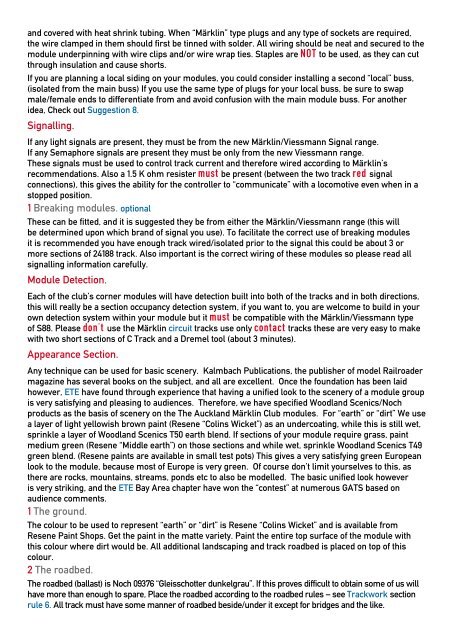The Auckland Märklin Club Inc - The Auckland Marklin Club Inc
The Auckland Märklin Club Inc - The Auckland Marklin Club Inc
The Auckland Märklin Club Inc - The Auckland Marklin Club Inc
Create successful ePaper yourself
Turn your PDF publications into a flip-book with our unique Google optimized e-Paper software.
and covered with heat shrink tubing. When “<strong>Märklin</strong>” type plugs and any type of sockets are required,<br />
the wire clamped in them should first be tinned with solder. All wiring should be neat and secured to the<br />
module underpinning with wire clips and/or wire wrap ties. Staples are NOT to be used, as they can cut<br />
through insulation and cause shorts.<br />
If you are planning a local siding on your modules, you could consider installing a second “local” buss,<br />
(isolated from the main buss) If you use the same type of plugs for your local buss, be sure to swap<br />
male/female ends to differentiate from and avoid confusion with the main module buss. For another<br />
idea, Check out Suggestion 8.<br />
Signalling.<br />
If any light signals are present, they must be from the new <strong>Märklin</strong>/Viessmann Signal range.<br />
If any Semaphore signals are present they must be only from the new Viessmann range.<br />
<strong>The</strong>se signals must be used to control track current and therefore wired according to <strong>Märklin</strong>’s<br />
recommendations. Also a 1.5 K ohm resister must be present (between the two track red signal<br />
connections), this gives the ability for the controller to “communicate” with a locomotive even when in a<br />
stopped position.<br />
1 Breaking modules. optional<br />
<strong>The</strong>se can be fitted, and it is suggested they be from either the <strong>Märklin</strong>/Viessmann range (this will<br />
be determined upon which brand of signal you use). To facilitate the correct use of breaking modules<br />
it is recommended you have enough track wired/isolated prior to the signal this could be about 3 or<br />
more sections of 24188 track. Also important is the correct wiring of these modules so please read all<br />
signalling information carefully.<br />
Module Detection.<br />
Each of the club’s corner modules will have detection built into both of the tracks and in both directions,<br />
this will really be a section occupancy detection system, if you want to, you are welcome to build in your<br />
own detection system within your module but it must be compatible with the <strong>Märklin</strong>/Viessmann type<br />
of S88. Please don’t use the <strong>Märklin</strong> circuit tracks use only contact tracks these are very easy to make<br />
with two short sections of C Track and a Dremel tool (about 3 minutes).<br />
Appearance Section.<br />
Any technique can be used for basic scenery. Kalmbach Publications, the publisher of model Railroader<br />
magazine has several books on the subject, and all are excellent. Once the foundation has been laid<br />
however, ETE have found through experience that having a unified look to the scenery of a module group<br />
is very satisfying and pleasing to audiences. <strong>The</strong>refore, we have specified Woodland Scenics/Noch<br />
products as the basis of scenery on the <strong>The</strong> <strong>Auckland</strong> <strong>Märklin</strong> <strong>Club</strong> modules. For “earth” or “dirt” We use<br />
a layer of light yellowish brown paint (Resene “Colins Wicket”) as an undercoating, while this is still wet,<br />
sprinkle a layer of Woodland Scenics T50 earth blend. If sections of your module require grass, paint<br />
medium green (Resene “Middle earth”) on those sections and while wet, sprinkle Woodland Scenics T49<br />
green blend. (Resene paints are available in small test pots) This gives a very satisfying green European<br />
look to the module, because most of Europe is very green. Of course don’t limit yourselves to this, as<br />
there are rocks, mountains, streams, ponds etc to also be modelled. <strong>The</strong> basic unified look however<br />
is very striking, and the ETE Bay Area chapter have won the “contest” at numerous GATS based on<br />
audience comments.<br />
1 <strong>The</strong> ground.<br />
<strong>The</strong> colour to be used to represent “earth” or “dirt” is Resene “Colins Wicket” and is available from<br />
Resene Paint Shops. Get the paint in the matte variety. Paint the entire top surface of the module with<br />
this colour where dirt would be. All additional landscaping and track roadbed is placed on top of this<br />
colour.<br />
2 <strong>The</strong> roadbed.<br />
<strong>The</strong> roadbed (ballast) is Noch 09376 “Gleisschotter dunkelgrau”. If this proves difficult to obtain some of us will<br />
have more than enough to spare, Place the roadbed according to the roadbed rules – see Trackwork section<br />
rule 6. All track must have some manner of roadbed beside/under it except for bridges and the like.



